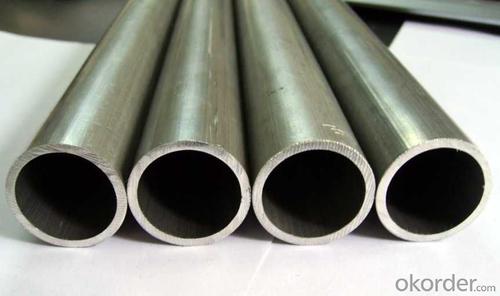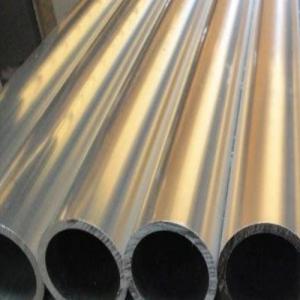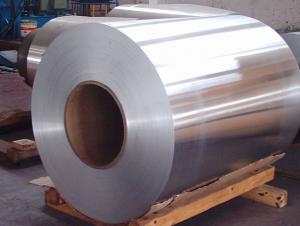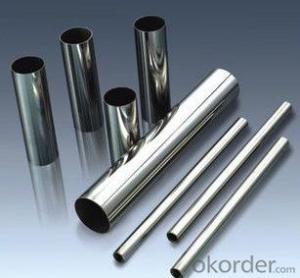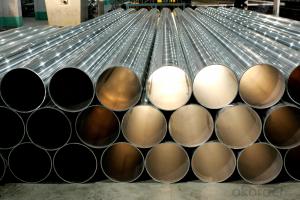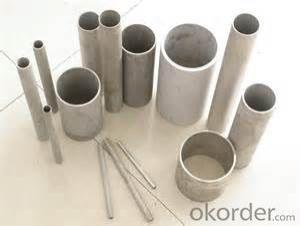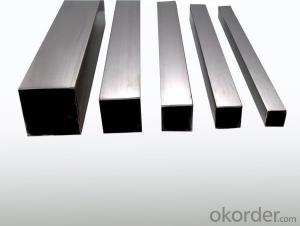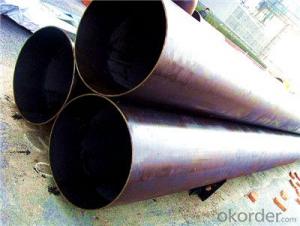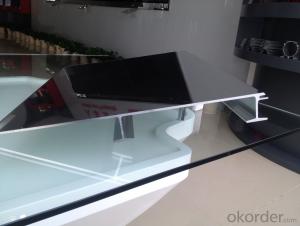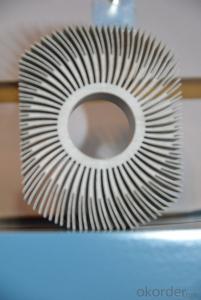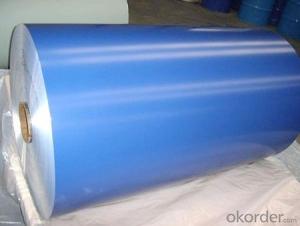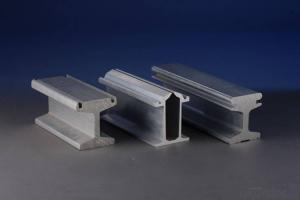Aluminum Pipes - Aluminum Seamless Tube Alloy 5000
- Loading Port:
- China Main Port
- Payment Terms:
- TT OR LC
- Min Order Qty:
- -
- Supply Capability:
- -
OKorder Service Pledge
Quality Product, Order Online Tracking, Timely Delivery
OKorder Financial Service
Credit Rating, Credit Services, Credit Purchasing
You Might Also Like
Specification of aluminum tube/pipe
Alloy: | 2A12, 2014, 2014A, 2017A, 2024, 3003, 5005, 5754, 5083, 7020, 7075 etc |
Temper: | O F T3-T6 |
Out diameter: | 15-220mm |
Wall thickness: | 1.0-60mm |
Length: | 6000mm or as need |
We can provide a full range services including: extrusion, anodizing, machining . we produce aluminium extrusions, aluminum tube, seamless aluminum tube, aluminum bar, aluminum angle, aluminum channels, and industry profiles, in a wide range of commercial alloys, including 1050, 1200, 2A12, 2014, 2014A, 2017A, 2024, 3003, 5083, 6005A, 6060, 6061, 6063, 6063A, 6082, 6463, 7020, 7075 subject to temper requirements and product specification.
Aluminium profiles(classifcation according to surface treatment requirements)
1,Anodizing profiles
2,Electrophresis profiles
3,Powder coating profiles
4,Wood finish profiles
5,Polished profiles
6,PVDF coating profiles
- Q: How do aluminum pipes compare to titanium pipes in terms of weight?
- In general, titanium pipes tend to be heavier than aluminum pipes. This is because titanium has a higher density than aluminum, resulting in titanium pipes weighing more than aluminum pipes of the same size. This quality makes aluminum pipes more suitable for industries like aerospace or automotive, where reducing weight is a top priority. Nevertheless, it is crucial to acknowledge that titanium pipes offer exceptional strength and durability, making them perfect for applications that demand resistance to corrosion, extreme temperatures, or heavy loads. Ultimately, deciding between aluminum and titanium pipes relies on the specific needs of the intended application.
- Q: Can aluminum pipes be used for conveyor systems?
- Yes, aluminum pipes can be used for conveyor systems. Aluminum is a lightweight and durable material that is commonly used in conveyor systems. It offers several advantages such as corrosion resistance, high strength-to-weight ratio, and ease of fabrication. Aluminum pipes are often used in conveyor systems for industries such as food processing, packaging, and manufacturing. They can be easily assembled, disassembled, and reconfigured to meet specific layout requirements. Additionally, aluminum pipes can be an economical choice as they require minimal maintenance and have a long lifespan.
- Q: Can aluminum pipes be bent or shaped easily?
- Yes, aluminum pipes can be bent or shaped relatively easily due to their malleability and ductility.
- Q: Are aluminum pipes suitable for wastewater treatment plants?
- Aluminum pipes are indeed a suitable choice for wastewater treatment plants. Their lightweight and corrosion-resistant nature make them perfect for environments where exposure to corrosive substances in wastewater is probable. Moreover, the installation and maintenance of aluminum pipes are hassle-free, resulting in reduced costs and effort for operating the wastewater treatment plant. However, it is crucial to consider several factors, including the type of wastewater being treated, the concentration of chemicals, and the plant's operating conditions, to determine if aluminum pipes are the best fit. Consulting experts and engineers in the field is highly recommended to select the most suitable materials for a specific wastewater treatment plant.
- Q: What is the average lifespan of aluminum pipes?
- The lifespan of aluminum pipes can vary due to factors such as material quality, usage environment, and maintenance. On the whole, aluminum pipes have a long lifespan and can endure for many decades. By installing them correctly, conducting regular inspections, and making timely repairs, aluminum pipes can fulfill their intended purpose for 30 to 50 years or more. Nevertheless, it is crucial to acknowledge that external elements like corrosion, exposure to harsh chemicals, or extreme temperature fluctuations can greatly affect the lifespan of aluminum pipes. Hence, regular maintenance and periodic assessments are necessary to guarantee the durability and effectiveness of aluminum pipes.
- Q: Can aluminum pipes be used for airport terminals?
- Airport terminals can indeed utilize aluminum pipes. Aluminum is a popular material choice for a wide range of applications in airport terminals, thanks to its numerous benefits. To begin with, aluminum is lightweight, making it easier to handle during construction and installation. This can result in cost savings and quicker project completion times. Furthermore, aluminum pipes are resistant to corrosion, which is particularly important in environments like airport terminals that commonly experience moisture, humidity, and chemical exposure. This resistance to corrosion ensures the durability and longevity of the pipes, reducing the need for maintenance and replacement in the long term. Another advantage of aluminum pipes in airport terminals is their exceptional thermal conductivity. Aluminum pipes can efficiently transfer heat, making them suitable for applications such as HVAC systems. This property contributes to energy efficiency and cost savings in the terminal's operations. Additionally, aluminum is a sustainable material that can be easily recycled. This aligns with the growing emphasis on environmental responsibility in modern construction practices. By utilizing aluminum pipes, airport terminals can contribute to sustainable building practices and decrease their carbon footprint. To sum up, aluminum pipes can be effectively employed in airport terminals due to their lightweight nature, resistance to corrosion, thermal conductivity, and sustainability. Given these advantages, aluminum is a suitable material choice for various applications within airport terminal infrastructure.
- Q: What is the typical wall thickness of aluminum pipes?
- The specific application and industry standards play a significant role in the variation of wall thickness in aluminum pipes. Generally, aluminum pipes have a wall thickness that falls between 1/16 inch and 1/4 inch. The exact thickness relies on factors like pipe diameter, intended use, and the necessary strength and durability. To ensure the correct wall thickness for a specific project or application, it is crucial to refer to industry standards and specifications or seek advice from a professional engineer or supplier.
- Q: Are aluminum pipes suitable for power plants?
- Certain applications in power plants can make use of aluminum pipes, which offer a range of advantages. Firstly, aluminum's lightweight nature makes it convenient for handling and installation compared to alternative materials, thereby saving time and reducing labor costs during construction or maintenance tasks. Additionally, aluminum pipes possess exceptional resistance to corrosion, enabling them to withstand the demanding conditions often encountered in power plants, including high temperatures, humidity, and exposure to chemicals. Moreover, aluminum exhibits a commendable thermal conductivity, which facilitates efficient heat transfer, rendering it suitable for applications such as heat exchangers or cooling systems within power plants. Nevertheless, it is crucial to acknowledge that aluminum pipes might not be appropriate for all power plant applications. For instance, in systems with high pressure or involving extreme temperatures, other materials like steel or alloys may be more suitable. Thus, a thorough evaluation of the power plant's specific requirements and conditions is essential to determine the suitability of aluminum pipes for a given application.
- Q: resulting in the pipe can not be used after folding, how to deal with? Fifteen08 years to buy three AUX air-conditioning, moving this year, the pipe was folded, and then installed, AUX said after the sale of the pipe can not be used, to replace all new, because the aluminum pipe can not be welded. We all know that the tube is very expensive, then bought 5 meters or so, I think it will not have to spend money again, I did not expect, because of this reason, even for old pipes, the installation of new tubes, but also spend nearly 1000 yuan. When I bought it, I didn't think they would use the aluminum tube. I thought it was copper. It was entirely cost saving by the factory, which made the consumer pay the bill. I was so angry that I didn't buy anything from AUX any more. Would you like to ask if you have ever touched this situation? What can you do to reuse the old pipes?
- At that time, bought 5 meters or so, I think it will not have to spend money again, I did not expect, for this reason, even for the old pipe, the installation of new tubes, but also spend nearly 1000 yuan. They didn't think they could use aluminum tubes, but they thought they were copper...5 meters, 1000? How do you count it? 3 is the three AUX air conditioning are what count?Copper can buy it yourself, one meter 25--35 3P 1.5P meters, 60---70 to buy their own.Aluminum tube is folded, dead, or no folding, and that is the sense of aluminum tube can pass, if it can pass, you can use the tube folder.Thanks for taking it
- Q: What are the insulation requirements for aluminum pipes in cold climates?
- Insulation is necessary for aluminum pipes in cold climates to prevent heat loss and ensure efficient system operation. The specific insulation needs for these pipes depend on factors such as temperature range, fluid type, and pipe use. A primary purpose of insulation for aluminum pipes in cold climates is to prevent condensation. When the pipe surface temperature drops below the dew point, air moisture can condense on the pipe, leading to corrosion and potential system integrity issues. Insulation helps maintain the surface temperature above the dew point, preventing condensation and protecting the pipes from damage. To minimize heat transfer and maintain the desired fluid temperature, the insulation material for aluminum pipes in cold climates should have a high thermal resistance or R-value. Common insulation materials used for this purpose include mineral wool, fiberglass, polyurethane foam, and cellular glass. These materials have excellent thermal insulation properties and can be applied in various forms, including pre-formed sections, blankets, or spray-on coatings. The thickness of the insulation layer depends on the desired thermal resistance and system requirements. It is important to consult local building codes and standards to ensure compliance with recommended insulation thickness for aluminum pipes in cold climates. Additionally, the insulation should be properly sealed and protected to prevent moisture ingress, which could reduce its insulating effectiveness. Along with thermal insulation, aluminum pipes in cold climates may require additional measures such as heat tracing or electric heating cables to maintain fluid temperature during significant drops in ambient temperature. These systems provide an additional layer of protection against freezing and ensure continuous system operation. In conclusion, the insulation requirements for aluminum pipes in cold climates involve selecting suitable insulation materials, determining the necessary thickness, and considering additional measures to maintain the desired temperature. Consulting experts or professionals in the field is crucial to ensure that the insulation meets specific system needs and complies with relevant regulations.
Send your message to us
Aluminum Pipes - Aluminum Seamless Tube Alloy 5000
- Loading Port:
- China Main Port
- Payment Terms:
- TT OR LC
- Min Order Qty:
- -
- Supply Capability:
- -
OKorder Service Pledge
Quality Product, Order Online Tracking, Timely Delivery
OKorder Financial Service
Credit Rating, Credit Services, Credit Purchasing
Similar products
Hot products
Hot Searches
Related keywords

